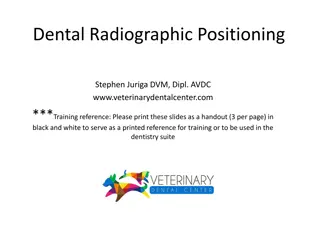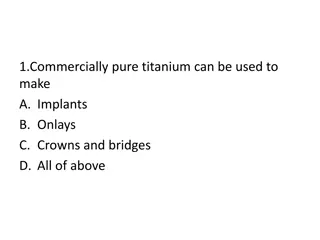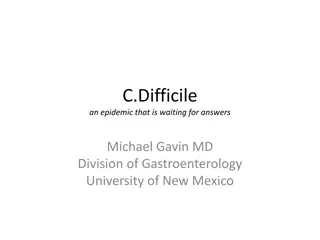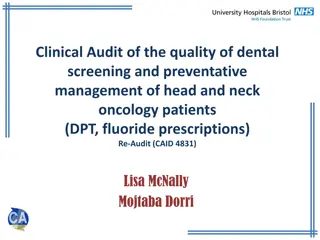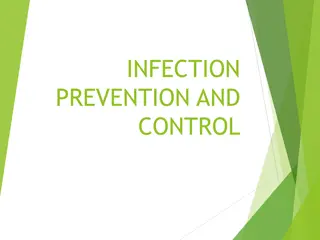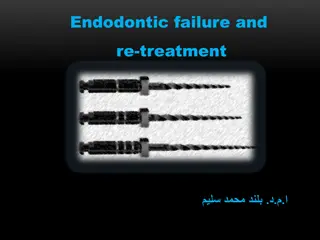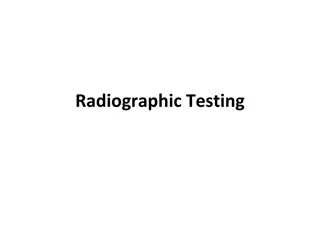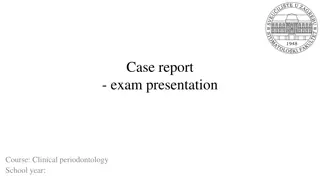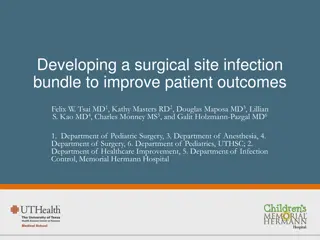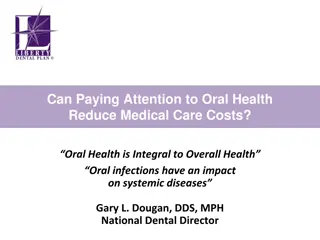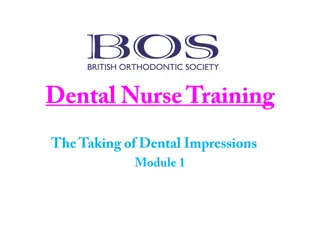Radiographic Infection Control in Dental Clinics
In dental radiology clinics, infection control is crucial to prevent cross-contamination and disease transmission among patients and staff. Key steps include applying standard precautions, wearing personal protective equipment, disinfecting equipment, and preventing contamination of processing equipment. Standard precautions treat all blood and saliva as potentially infectious, emphasizing the need for protective measures. The potential for cross-contamination is high in dental radiography, necessitating proper handling of instruments and education of staff members.
- Dental radiology
- Infection control
- Cross-contamination
- Standard precautions
- Personal protective equipment
Download Presentation

Please find below an Image/Link to download the presentation.
The content on the website is provided AS IS for your information and personal use only. It may not be sold, licensed, or shared on other websites without obtaining consent from the author. Download presentation by click this link. If you encounter any issues during the download, it is possible that the publisher has removed the file from their server.
E N D
Presentation Transcript
Infection control in radiology clinic Assistant. Prof. Areej Ahmed
Introduction Objectives Key steps in radiographic infection control
Introduction Dental personnel and patients are at increased risk for acquiring tuberculosis, HIV, herpes viruses, upper respiratory infections, and hepatitis strains A through E. The primary goal of infection control procedures is to prevent cross-contamination and disease transmission from patient to staff, from staff to patient, and from patient to patient.
The potential for cross-contamination in dental radiography is great. Cross-contamination can be happened in different way: 1. an operator's hands become contaminated by contact with a patient's mouth and saliva-contaminated films and film holders. Then the operator also must adjust the x-ray tube head and x-ray machine control panel settings to make the exposure. 2. an operator handles digital sensors or opens film packets to process the films in the darkroom. The dentist is responsible for minimizing or eliminating cross- contamination procedures. And responsible also to educates other members of the practice.
Key Steps in Radiographic Infection Control Apply standard precautions Wear personal protective equipment during all radiographic procedures Disinfect and cover x-ray machine, working surfaces, chair, and apron Sterilize nondisposable instruments Use barrier-protected film (sensor) or disposable container Prevent contamination of processing equipment
Standard Precautions Standard precautions (also called universal precautions) are infection control practices designed to protect workers from exposure to diseases spread by blood and certain body fluids, including saliva. Under standard precautions, all human blood and saliva are treated as infectious for human immunodeficiency virus (HIV) and hepatitis B virus. Accordingly, the means used to protect against cross-contamination are used for all individuals. because many patients are unaware that they are carriers of infectious disease or choose not to reveal this information.
Wear Personal Protective Equipment During All Radiographic Procedures Personal protective equipment is an effective means to shield the operator from exposure to potentially infectious material, including blood and saliva. Hand hygiene is most important to prevent spread of infections. Disposable gloves should be worn in sight of the patient Operators should wear protective clothing (e.g., disposable gown or laboratory coat)
Disinfect and Cover Clinical Contact Surfaces Clinical contact surfaces are surfaces that might be touched by gloved hands or instruments that go into the mouth. These include the x-ray machine and control panel, chair-side computer, beam alignment device, dental chair and headrest, protective apron, thyroid collar, and surfaces on which the receptor is placed.
These are noncritical items. These are objects that may come in contact with saliva, blood, or intact skin but not oral mucous membranes. The goal of preventing cross- contamination is by disinfecting all such surfaces and by using barriers to isolate equipment from direct contact. Barriers made of clear plastic wrap should cover working surfaces that were previously cleaned and disinfected, and should be changed when damaged and routinely after each patient.
Intermediate- and low level activity disinfectants recommended for use on clinical contact surfaces. Intermediate-level disinfectants are Environmental Protection Agency (EPA)- registered agents and are tuberculocidal an effective killer of tuberculosis and capable of preventing other infectious diseases, including hepatitis B virus and HIV. Low-level disinfectants are EPA registered without tuberculocidal activity but inactivate hepatitis B virus and HIV. High-level disinfectants are used for chemical sterilization and should never be used on clinical contact surfaces.
Panoramic chin rest and patient handgrips should be cleaned with a low-level disinfectant. Disposable biteblocks may be used. The head-positioning guides, control panel, and exposure switch should be carefully wiped with a paper towel that is well moistened with disinfectant. Cephalostat ear posts, ear post brackets, and forehead support or nasion pointer should be cleaned and disinfected. These may then also be covered with a plastic barrier.
Sterilize Non disposable Instruments Film -holding instruments are classified as semicritical items instruments that are not used to penetrate soft tissue or bone but do come in contact with the oral mucous membrane. It is best to use film-holding instruments that can be sterilized, preferably by steam under pressure (autoclave). After using these instruments, disassemble the aiming ring, support arm, and bite-block. Each instrument should be cleaned with hot water and soap to remove saliva and debris. The cleaned components are then loaded into plastic or paper pouches and sterilized in an autoclave.
Use Barriers With Digital Sensors Digital Sensors cannot be sterilized by heat, so a plastic barrier used to protect them from contamination when placed in the patient's mouth. The supplemental use of latex finger cots provides significant added protection and is recommended for routine use when using digital sensors. Because such barriers may fail, the sensors should be cleaned and disinfected with an EPA registered, intermediate-level hospital disinfectant after every patient.
Prevent Contamination of Processing Equipment After all film exposures are made, the operator should remove his or her gloves and take the container of contaminated films to the darkroom. The goal in the darkroom is to break the infection chain so that only clean films are placed into processing solutions. Two towels should be placed on the darkroom working surface. The container of contaminated films should be placed on one of these towels. After the exposed film is removed from its packet, it should be placed on the second towel. The film packaging is discarded on the first towel with the container.
Thanks for your listening



